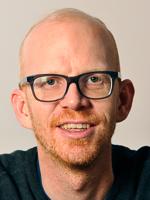Seminario Reidar Lund, Università di Oslo, Norvegia
Luciano Galantini ha il piacere di invitarvi al seminario:
Antimicrobial peptides: from the basic mode-of-action to antimicrobial nanoparticles
Reidar Lund, University of Oslo, Norway
Il seminario si terrà martedì 2 luglio alle ore 11 in Aula B, ed. S. Cannizzaro (CU014).
Abstract
It is generally believed that antimicrobial peptides, AMPs, are able to evade much of the bacterial resistance because they disturb the fundamental integrity of the entire cell by interfering with the life-defining cell membrane. However, there is no clear general consensus for the molecular basis by which AMPs act, although various structural modifications such as membrane deformation or pore formation have been suggested. [1,2] In addition, AMPs are often unstable towards enzymatic degradation and consequently display limited circulation in the blood stream.
In this project the focus is two-folded. First, we investigate the mechanism of natural AMPs using scattering methods combined with model systems for both bacterial and mammalian membranes. Secondly, we focus on nanostructured peptides created by self-assembly, or through polymer co-assembly with the aim of improving the stability and achieve more efficient drug-delivery of AMPs.
We heavily rely on small-angle X-ray and neutron scattering (SAXS/SANS) methods which are capable to probe the structure and dynamics of both lipids and peptide on nanometer length scales [3,4]. Through SAXS we determine the insertion into the membrane and specifically investigate possible pore formation. By using SANS and H/D contrast variation scheme we address the lateral organization of membranes containing lipid rafts (nanodomains). Surprisingly the data show that AMPs do not act as “lineactants” but rather leads to growth of the domains.[5] Using time resolved SANS we study the lipid dynamics extracting both the transversal flip flop motion as well as lipid exchange. The results further show that although the structure of the peptide within the membrane differs, all AMPs cause a markedly faster lipid dynamics [6,7] We speculate that the change in dynamics may cause effects that are detrimental to the bacterial cell through enhanced ion transport or lipid scrambling. In the second part we will discuss, antibiotic nanoparticles based on either self-assembly of peptide-polymer conjugates[8] or formation of peptide polymer coacervates. [9] In the talk, we will discuss various aspects of NP stability, peptide-lipid-membrane interactions and biological activity.
References
[1] H. Jenssen, P. Hamill and R. E. W. Hancock, Clinical Microbiology Reviews, 2006, 19, 491–511.
[2] W. C., Wimley, ACS Chemical biology 2010, 5 (10), 905-917.
[3 ] J.E. Nielsen, J. E., V:A. Bjørnestad, & R. Lund, Soft Matter, 2018, 11, 37–14.
[4] Nielsen, J. E., Lind, T. K., Lone, A., Gerelli, Y., Hansen, P. R., Jenssen, H. M, Cárdenas and R. Lund BBA - Biomembranes, 1861(7), 1355–1364.
[5] Koynarev, V.R.; Almåsvold Borgos, K.A.; Porcar, L.: Kohlbrecher, J.; Eilsø Nielsen, J. And Lund, R. 2024. Under review
[6] Nielsen, J. E.; Bjørnestad, V. A.; Pipich, V.; Jenssen, H.; Lund, R.. Journal of Colloid and Interface Science 2021, 582, 793–802.
[7 ] Nielsen, J. E.; Prevost, S.; Lund, R. Faraday Discussions. 2021,232, 203-217
[8] König, N.; Szostak, S. M.; Nielsen, J. E.; Dunbar, M.; Yang, S.; Chen, W.; Benjamin, A.; Radulescu, A.; Mahmoudi, N.; Willner, L.; Keten, S.; Dong, H.; Lund, R. ACS Nano 2023, 17 (13), 12394–12408.
[9] Vogelaar, T.; Agger, A.; Linke, D.; Reseland, J.; Jenssen, H. and Lund, R. 2024 Biomacromolecules accepted for publication
Reidar Lund Short Bio 
Reidar Lund obtained his PhD in 2004 at Forschungszentrum Jülich, University of Münster in Germany. After several postdoctoral stays at Forschungszentrum Jülich, Germany, the University of the Basque Country, Spain and UC-Berkeley, USA, he was appointed Associate Professor at the University of Oslo, Norway in 2016 and promoted to full Professor in 2022 at the same place. He is also an associate researcher at the Norwegian Centre for Molecular Medicine (NCCM), a branch of the Nordic European Molecular Biology Laboratory (EMBL) and at the “Hylleraas Centre for Quantum Molecular Sciences” - a Centre of Excellence in Norway.
